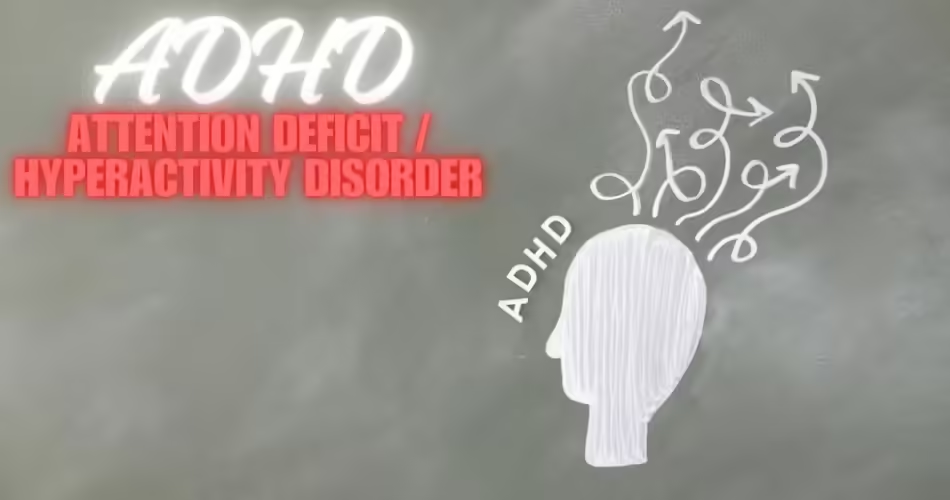This blog will provide you information about ADHD. It will tell you what ADHD stands for. It will tell you about what type of disorder ADHD is. This blog will also highlight the main Causes of ADHD. After causes, it will elaborate the symptoms of ADHD. We will also learn about the Difference between ADHD and OCD. Then we will discuss the Types of ADHD. At the end we will learn about the Treatment, Medications and Management of ADHD. This blog contain Causes, Symptoms, Types and Treatment of ADHD in detail.
1.ADHD stands for:
ADHD stands for Attention Deficit Hyperactivity Disorder. It is a neurological condition. This blog contains Information about ADHD, its causes, symptoms, types and treatment in detail.
2.What is ADHD?
It is the most common neuro-developmental disorders of childhood so it is usually first diagnosed in childhood and often lasts into adulthood. Children with ADHD have trouble paying attention, controlling impulsive behaviors, or be overly active.
ADHD is considered as a chronic and debilitating disorder as it effects different aspects of life of an individual, including professional achievements, interpersonal relationships, and daily functioning etc.
It leads to poor self-esteem and social function of children that are not treated appropriately. While adults with ADHD face poor self-worth, sensitivity towards criticism and increased self criticism.
Many children may have difficulties sitting straight, waiting their turn, paying attention, being fidgety, and acting impulsively. However, children who meet diagnostic criteria for ADHD, may have different symptoms of hyperactivity, impulsivity, organization, and/or inattention are noticeably greater than expected for their age or developmental level.
ADHD highly effects the patients throughout their life. Because it never let them to behave normally in situations. People with ADHD feel difficulty in tackling their personal as well as social lives to live in a normal way. This may lead to cause a distance between the patient and the people in his life so lets discuss the Causes, Symptoms, Types and Treatment of ADHD.
3.Causes of ADHD:
Scientists are studying causes and risk factors in an effort to find better ways to manage and reduce the chances of a person having ADHD. Recent studies link genetic factors with ADHD.
In addition to genetics, scientists are studying other possible causes and risk factors including:
Brain injury
Exposure to environmental risks (e.g., lead) during pregnancy or at a young age
Alcohol and tobacco use during pregnancy
Low birth weigh
Research does not support the popularly held views that ADHD is caused by eating too much sugar, watching too much television, parenting, or social and environmental factors such as poverty or family chaos.
4.Symptoms of ADHD:
The children with ADHD can have following symptoms:
Daydream a lot
Forget or lose things a lot
Squirm or fidget
Talk too much
Make careless mistakes or take unnecessary risks
Have a hard time resisting temptation
Can Have trouble taking turns
Have difficulty getting along with others
These are the main symptoms of ADHD.

5. ADHD VS OCD:
ADHD
- It is a neuro-developmental disorder.
- It is a Hyperactivity disorder in young children.
- It is impulsive and risk taking.
- Constant need for stimulation and feel boring most often.
- Craves novelty and new experiences.
OCD
- It is a mental disorder or mental health illness.
- It is the disorder that leads obsessions and compulsions in a patient so makes them irritable.
- It is creates a risk-avoiding personality.
- Recurrent and persistent thoughts and urges.
- Craves routine and familiarity.
6.Types of ADHD:
This blog contains Causes, Symptoms, Types and Treatment of ADHD. There are three different ways ADHD presents itself, depending on which types of symptoms are strongest in the individual:
Predominantly Inattentive Presentation:
It is hard for the individual to organize or finish a task, to pay attention to details, or to follow instructions or conversations and so the person is easily distracted or forgets details of daily routines. This highly effects daily activities of the patient. We have to be very careful in treating the patients exposed to this condition.
Predominantly Hyperactive-Impulsive Presentation:
The person fidgets and talks a lot. It is hard to sit still for long (e.g., for a meal or while doing homework). Smaller children may run, jump or climb constantly and so the individual feels restless and has trouble with impulsivity. It really effects the social life of the patient as people don’t want to spend time with them or get scared with their unusual behavior so this condition should be treated with great care.
Combined Presentation:
Symptoms of the above two types are equally present in the person. Because symptoms can change over time, the presentation may change over time as well. In this condition, a person may feel difficulty in understanding instruction and may talk a lot so both of the above conditions are collectively called as combined presentation of ADHD.
After discussing the types, symptoms and causes of ADHD, lets talk about Treatments.
7.Treatment For ADHD:
In most cases, ADHD is best treated with a combination of behavior therapy and medication. For preschool-aged children (4-5 years of age) with ADHD, behavior therapy, particularly training for parents, is recommended as the first line of treatment before medication is tried. Following are some treatments for ADHD:
Behavioral Therapy:
Behavioral therapy helps to recognize the negative aspects of behavior of the patient. This helps to point out the bad behavior of the patient and help them to work on it. This is a harmless way of treating psychological disorder such as bipolar disorder and ADHD.
Psychotherapy:
Psychotherapy is the therapy that uses psychological logics in order to treat the patient facing psychological disorders. It is a suitable way to treat ADHD. It can also help to find out the actual cause of psychological disorders.
Social Skill Training:
We can also treat ADHD by social skill training. These trainings helps in teaching the patient how to react and behave socially or in social gatherings and so this helps the patient to try to control his or her behavior in front of people and helps to behave normally.
Support Groups:
These are the gatherings in which people with same psychological or medical issues sit together and exchange their thoughts so this really helps the patients to learn about their problems and learn how to solve them solve them by ideas given by other patients.
All of these treatments can be used to treat ADHD.
Medication of ADHD:
There are two types of medications we can use in ADHD:
Stimulants:
Stimulants works to boost and balance levels of brain chemicals called neurotransmitters so as these controls and balance the activities of brain. These are the most commonly prescribed medicines for ADHD.
Other Medications:
Other medications include non-stimulant atomoxetine and few antidepressants such as bupropion. Atomoxetine and antidepressants work slower than stimulants do, but these may be good options if you can’t use stimulants because of health problems or if stimulants cause severe side effects.
In extreme cases, we use medication.
Management of the Symptoms of ADHD:
ADHD patients can manage the symptoms by following precautions:
Maintaining healthy diet
Eating vegetables and fruits
Physical activity (Regularly)
Limiting the screen time
Getting recommended amount of sleep.
By following these rules a person can manage the potential symptoms of ADHD.
8.Conclusion:
ADHD is the most common neurodevelopmental disorder in children. It is diagnosed in childhood and then remains till adulthood. We can work on it by few behavioral therapies, medication and taking some precautions in daily lifestyle. A person is not able to understand instructions in this condition and so in some cases the person is hyperactive and do not understand things easily. We should treat ADHD patients with a lot of care. We should give special attention to the kids having ADHD.

To read about more disease, click the links below:


Comments